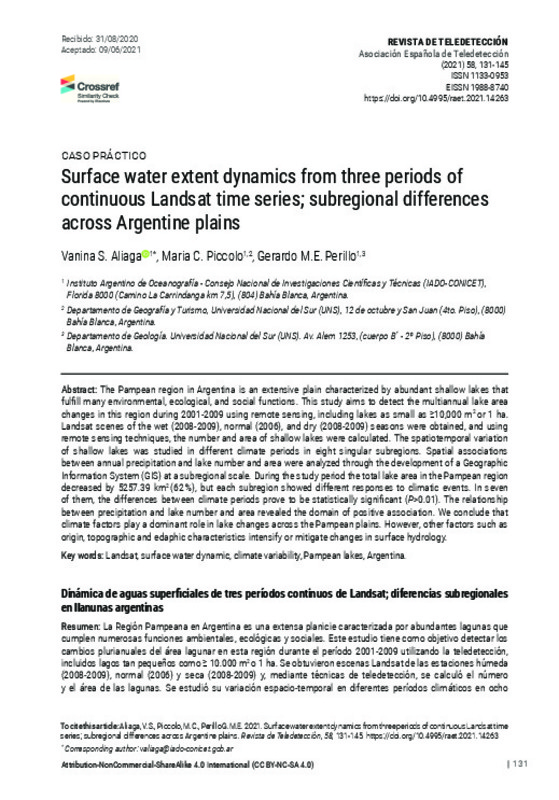|
Resumen:
|
[EN] The Pampean region in Argentina is an extensive plain characterized by abundant shallow lakes that fulfill many environmental, ecological, and social functions. This study aims to detect the multiannual lake area ...[+]
[EN] The Pampean region in Argentina is an extensive plain characterized by abundant shallow lakes that fulfill many environmental, ecological, and social functions. This study aims to detect the multiannual lake area changes in this region during 2001-2009 using remote sensing, including lakes as small as ≥10,000 m2 or 1 ha. Landsat scenes of the wet (2008-2009), normal (2006), and dry (2008-2009) seasons were obtained, and using remote sensing techniques, the number and area of shallow lakes were calculated. The spatiotemporal variation of shallow lakes was studied in different climate periods in eight singular subregions. Spatial associations between annual precipitation and lake number and area were analyzed through the development of a Geographic Information System (GIS) at a subregional scale. During the study period the total lake area in the Pampean region decreased by 5257.39 km2 (62 %), but each subregion showed different responses to climatic events. In seven of them, the differences between climate periods prove to be statistically significant (P>0.01). The relationship between precipitation and lake number and area revealed the domain of positive association. We conclude that climate factors play a dominant role in lake changes across the Pampean plains. However, other factors such as origin, topographic and edaphic characteristics intensify or mitigate changes in surface hydrology.
[-]
[ES] La Región Pampeana en Argentina es una extensa planicie caracterizada por abundantes lagunas que cumplen numerosas funciones ambientales, ecológicas y sociales. Este estudio tiene como objetivo detectar los cambios ...[+]
[ES] La Región Pampeana en Argentina es una extensa planicie caracterizada por abundantes lagunas que cumplen numerosas funciones ambientales, ecológicas y sociales. Este estudio tiene como objetivo detectar los cambios plurianuales del área lagunar en esta región durante el período 2001-2009 utilizando la teledetección, incluidos lagos tan pequeños como ≥ 10.000 m2 o 1 ha. Se obtuvieron escenas Landsat de las estaciones húmeda (2008-2009), normal (2006) y seca (2008-2009) y, mediante técnicas de teledetección, se calculó el número y el área de las lagunas. Se estudió su variación espacio-temporal en diferentes períodos climáticos en ocho subregiones singulares. Se analizaron las correlaciones espaciales entre la precipitación anual y el número y el área de los lagos mediante el desarrollo de un Sistema de Información Geográfica (SIG). Durante el período de estudio el área total de lagos en la región pampeana disminuyó en 5.257,39 km2 (62 %), pero cada subregión mostró diferentes respuestas a los eventos climáticos. En siete de ellos, las diferencias entre periodos climáticos resultan estadísticamente significativas (P>0,01). La relación entre la precipitación con el número y área de las lagunas reveló el dominio de asociaciones positivas. Si bien el clima juega un papel dominante en los cambios en las lagunas de planicie, otros factores, como el origen, las características topográficas y edáficas, intensifican o mitigan los cambios en la hidrología superficial.
[-]
|
|
Agradecimientos:
|
Authors would like to thank the Consejo Nacional de Investigaciones Científicas y Técnicas for supporting this study. Besides, to the United States Geological Survey for supplying the information analyzed in this study. ...[+]
Authors would like to thank the Consejo Nacional de Investigaciones Científicas y Técnicas for supporting this study. Besides, to the United States Geological Survey for supplying the information analyzed in this study. This work was carried out with the aid of a grant from the Inter-American Institute for Global Change Research (IAI) CRN3038, which is supported by the US National Science Foundation (Grant GEO-1128040)
[-]
|







